Music in a video can create a good mood and keeps your viewers watching your video. But do you know, the same music can do more harm than good if you use unlicensed stock audio? Your YouTube channel could be banned or your YouTube video can take down.
For its solution, you have to hire a commercial music producer to produce unique tracks for your videos or have an in-house team to do so which is very expensive. Don’t panic, you can avoid all of these headaches and keep creating better videos because…
I have found a few websites for your peace of mind that offer royalty free music for videos. Download music, sound effects, and more video assets for free or for a small fee, and use them confidently in your YouTube videos or commercial videos. Here is my top 5 choice…
Overall the Best
Twinkle
Twinkle is the best stock music suite for video creators and agencies. Twinkle tries to be the provider of this charm, wanting to transmit music and sounds.
Best for Professionals
Adobe Stock
Browse through a variety of over 200 Million creative and inspiring assets on Adobe Stock. Find the perfect assets instantly. Discover the best stock images.
For All Creators
Audio Jungle
Discover 1797550 royalty free music tracks and audio files for only $1 on AudioJungle. Buy royalty free music from a global community of musicians.
Best for YouTuber
Filmstock
Filmstock is your one-stop shop for royalty free effects, audio, and stock media. Over 10M+ of images, video footage clips, video effects, and audio tracks.
Beginner Friendly
Artlist
Artlist offers unlimited creative assets for content creators. Get the best royalty free music, SFX, stock footage, plugins, video editing software, and more.
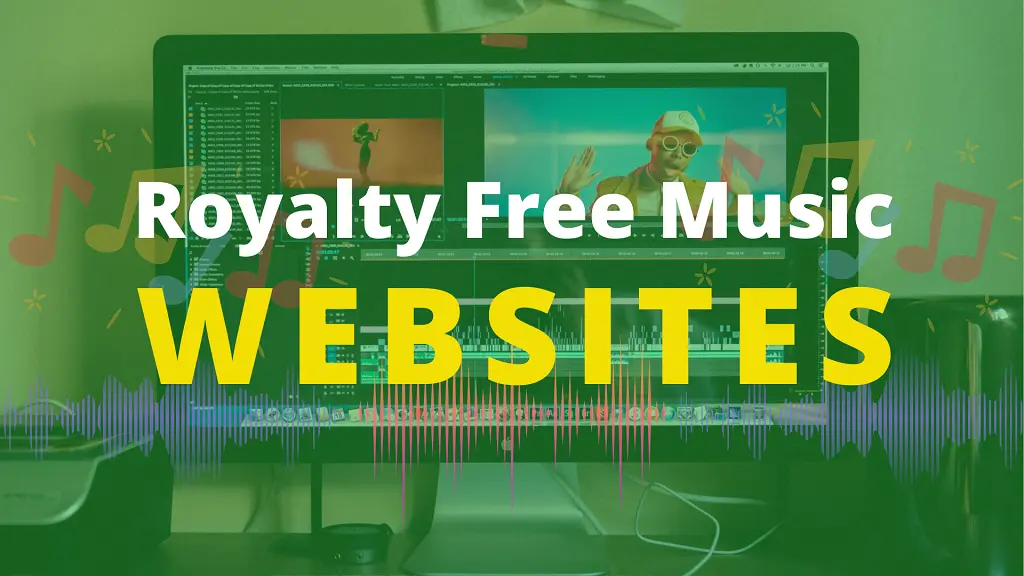
Here are the top 10 sound effects, royalty free music websites for videos that I am going to explore today:
- Twinkle
- Adobe Stock
- Audio Jungle
- Filmstock
- Artlist
- Soundstripe
- Bensound
- Filmstro
- YouTube Music Library
- Facebook Sound Collection
What is Royalty Free Music?
Music licensing, copyrights, and royalty-free songs are all terms you should be familiar with as a content creator. What do they mean? Music licensing terms such as “royalty free” can be confusing at times. Don’t worry, I’ll explain!
Simply put, “royalty-free” implies that you will not be required to pay royalty fees when licensing music or media. You don’t have to pay the song’s creator(s) through royalty-free media companies since they do it for you. Regardless, the owner of the music either gets paid or waives payment.
Therefore, royalty-free music can be used in YouTube videos, and Instagram reels without worrying about licensing fees.
Top 10 Sound Effects, Royalty Free Music Websites for Videos
In this blog post, I will share the top 10 websites you can use to get amazing copyright-safe music and sound effects for your videos:
Twinkle
Twinkle is the best stock music suite for video creators and agencies. Twinkle tries to be the provider of this charm, wanting to transmit music and sounds of the environment that will be seamlessly integrated into the videos and is currently considered the best software for the task.
One audio or music track doesn’t fit all videos. You need a variety of music tracks for logo stings, explainer videos, doodle videos, promo videos, corporate styles, kinetic typography, stomp teaser, and training video content.
And that’s why you’re going to LOVE Twinkle, which has a variety of music categories and VFX.
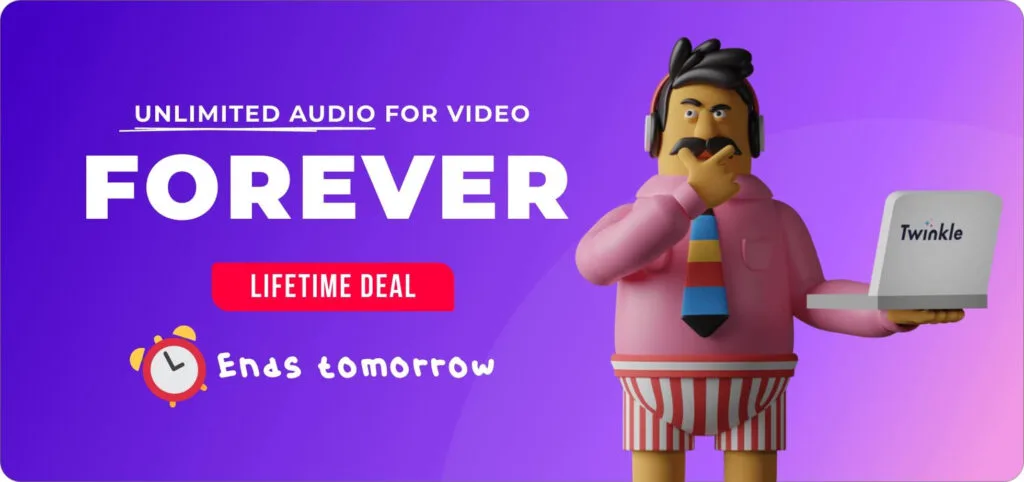
Twinkle’s Key Features
The following are the key features of Twinkle:
Affordable Price: Twinkle provides the user with two types of subscription options which are $49 or $99 one-time payment only. It’s one of the best audio sites for video because of its affordable pricing.
Royalty-free music: Twinkle provides you with a large variety of options when it comes to music and sound effects. Though Twinkle’s library is at its growing stage, they keep adding more royalty-free music and sound effects. Which keeps you away from the hassle of plagiarism.
Unlimited license: Twinkle provides you with unlimited licensed music for videos for a year rather than a short period, unlike other websites.
Customer Support: Twinkle keeps its customer’s happiness and great service before anything. Vidello is the company behind Twinkle. You can contact them through their Facebook group or by email.
Twinkle Pros and Cons
Here’s what I like about Twinkle:
- Price effective
- Fresh and new music
- Better customer service
- Text-to-Speech feature
Here’s what I don’t like about Twinkle:
- Trust issues of new consumers as it is not well-established.
Adobe Stock
Adobe Stock is a music library for video creators and agencies created by Adobe. Adobe was founded by John Warnock and Charles Reschke in the year 1982. Adobe stock was launched on 16 June 2015.
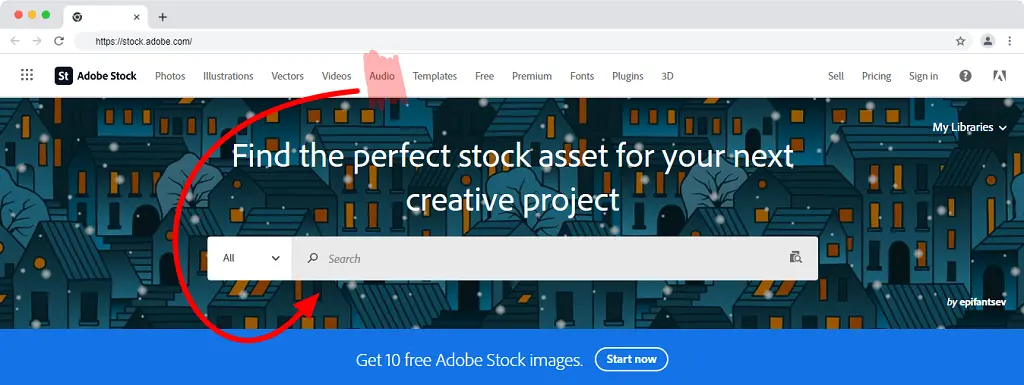
Adobe Stock’s Key Features
The following are the key features of Adobe Stock:
High quality music: Adobe has a well-established market name. So, it has easily collaborated with Epidemic Sound, Jamendo, and many more to offer high quality music for videos.
Licensing audio made simpler: it is very easy to license audio with help of adobe stock.
Intelligent search helps in fast search. Save the time of the user.
Different variety of music: being in the industry for so long they have a great quality of music and a wide range of options in music genres.
Adobe Stock Pros and Cons
Here’s what I like about Adobe Stock:
- Music for all kinds of moods and genres is available
- The consumer already established trust
- Easily accessible and easy to use
- The high retention rate of customers
- Adobe Stock offer 30 days free trial to test it.
Here’s what I don’t like about Adobe Stock:
- High priced but I love the Adobe stock collection.
Audio Jungle by Envato Market
The Audio Jungle is one of the best stock music websites available online. Cyan Ta’eed is the co-founder of Envato and is also the founder of the Audio Jungle. It was inspired by Siri. It was launched in 2008. Their music has been heard in television commercials to film productions, for companies including Toyota and Adidas.
Audio Jungle’s Key Features
The following are the key features of Audio Jungle:
Great variety: Different types of royalty-free music can be found. That goes with different kinds of software.
Huge community: Helps keep them ahead of their competitors. Also prevents them from being repetitive.
Effective price: Provides good quality royalty-free music at reasonable prices.
Provides the user with Premium quality: the user will find here premium quality music that they won’t find easily on other websites.
Audio Jungle Pros and Cons
Here’s what I like about Audio Jungle:
- Cheap price
- Great variety of options
- Good customer service
Here’s what I don’t like about Audio Jungle:
- Regular upgrades are needed
Filmstock
Filmstock provides the user with not only an audio library but also a stock video and image website. It is an initiative by Wondershare to help its users. Tobee Wu started Wondershare Technology Inc. in 2003. To create better solutions for life’s challenges and events was the vision of its founder Tobee Wu.
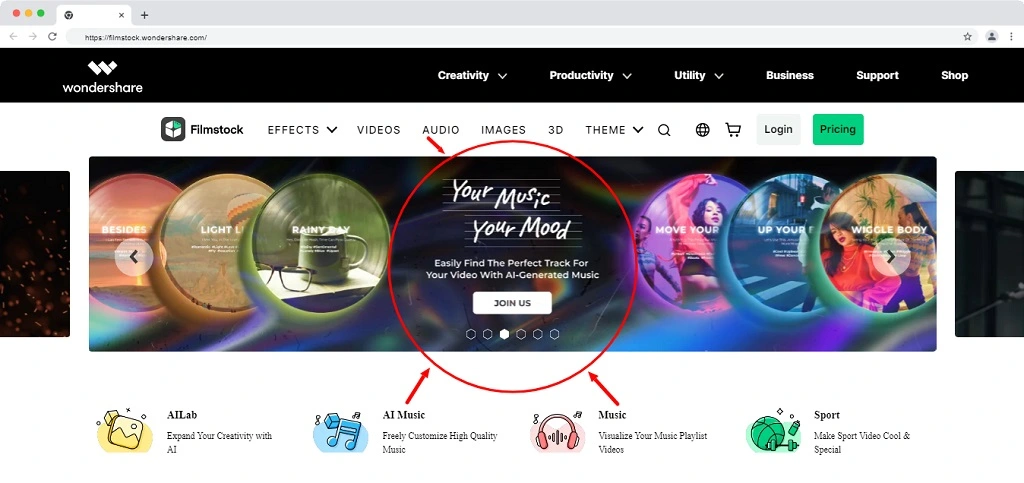
Filmstock’s Key Features
The following are the key features of Filmstock:
The impressive collection of 4d music: 4d music is a rare feature and it is not easily available on all websites.
Constantly growing audio library: This gives the user a great amount of variety to choose from.
Easily accessible: The audio can easily be found through the search box. The audio also can be easily extracted to use.
Standard pricing: The pricing of Filmstock is quite reasonable as they provide very good quality services.
Filmstock Pros and Cons
Here’s what I like about Filmstock:
- Constantly updating the collection of stock music and footage
- Affordable prices
Here’s what I don’t like about Filmstock:
- You have to pay a price to use every feature.
Artlist
Founded in 2016 by Ira Belsky, Itzik Elbaz, Eyal Raz, and Assaf Ayalon as a music platform giving video content creators access to royalty-free music, Artlist is a leading creative technology company with three products that provide video creators with over 800K digital assets.
Artlist’s Key Features
The key features of the Artlist are:
Original music: Hand-picked by the world’s top indie artists. Which gives you different options for music from some of the best artists in the world.
Use anywhere: From YouTube monetization to commercial use worldwide, save you from the mental harassment of copyright strikes.
Fresh content: Artlist is one of the best providers of royalty-free music and free sound effects for YouTube, and its offerings have grown significantly since the company was founded. Without worrying about copyright strikes.
Soundstripe
Founded by Trevor Hinesley, Travis Terrell, and Micah Sannan in the year 2016. Everyone from young filmmakers to Microsoft or Volkswagen is acquiring rights from Soundstripe to have access to premium background music for video for their custom content.
Soundstripe’s Key Features
The key features of the sound stripe are:
High-quality: Soundstripe creates or acquires high-quality music, stock footage, and sound effects for use by its customers.
Flexible subscription model: The subscription model allows users to cancel at any time, and those items which have been utilized during the subscription period remain licensed in perpetuity for their specific uses.
Royalty-free music: Soundstripe provides you with a large variety of options when it comes to music and sound effects for video making. Though the Soundstripe library is at its growing stage, they keep adding more royalty-free music and sound effects, which keeps you away from the hassle of plagiarism.
Bensound
Bensound was created by Benjamin TISSOT also known as Bensound, a Composer and Musician based in France who has been creating music for more than 10 years. Founded in the year 2012. It has been one of the favorites of a video marketing strategist with experience.
Bensound’s Key Features
The key features of Bensound are:
Effective price: helps the user to lessen their production cost
Great variety: Different types of royalty-free music can be found. Which gives the user a variety of options to choose from.
Individual licensing: Bensound works with only a single song licensing and also with a subscription plan.
Filmstro
The user interface of Filmstro is simple and intuitive. It is also easy to browse their library. Filmstro may be the next best thing to having a composer at your fingertips. Filmstro gives you the ability to customize the momentum, depth, and power of songs using three faders. Filmstro is useful when you want to add a rich score to your video.
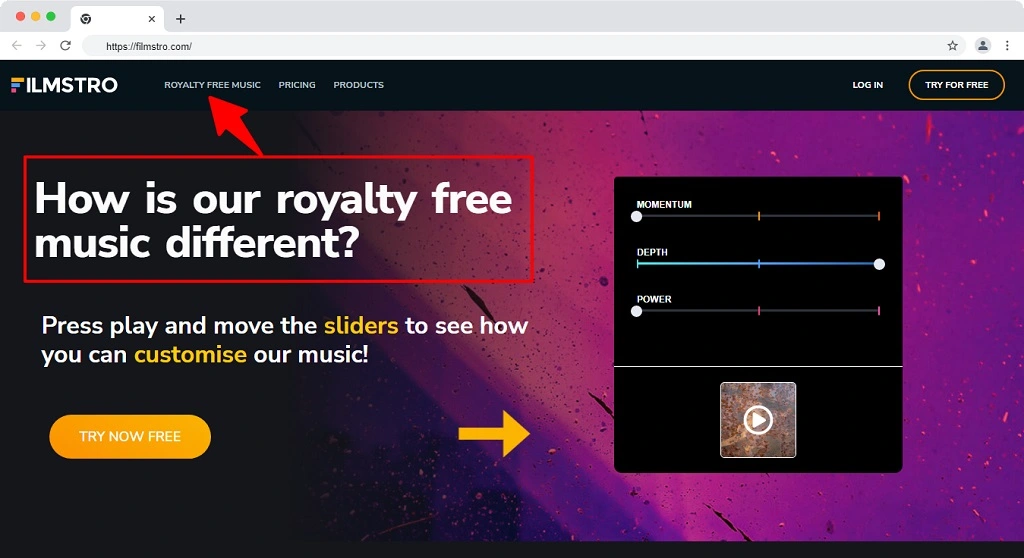
Though it isn’t suitable for every production music need, I think it can yield some great results. There are 60 albums in the Filmstro library, which is a decent size and makes finding good music somewhat easier. It’s not the largest library, but it’s big enough that you won’t run out of good things.
For those of you interested in trying them out, they even offer a free trial of their full library. It has high-quality pieces of music overall. Melodies that easily fit into video ads and social media posts.
The tool Filmstro may not be suitable for everyone. Audiences who are more interested in how sound and music are produced will find it appealing. Filmstro is a great tool for tweaking the sound effects for animation or beat and theme music of your video.
Some features that stand out and prove my opinion about Filmstro being a great tool for music editing tool are: Move Clip tool, Trim tool, Move the start and end times of soundtrack, and, Keyframe Graph Editor.
YouTube Music Library
Since 2013, YouTube has offered an Audio Library for creators of videos to find the music they need for their videos. It is a built-in feature that is available to YouTubers for free, which makes it easy and quick for them to find music for their videos.
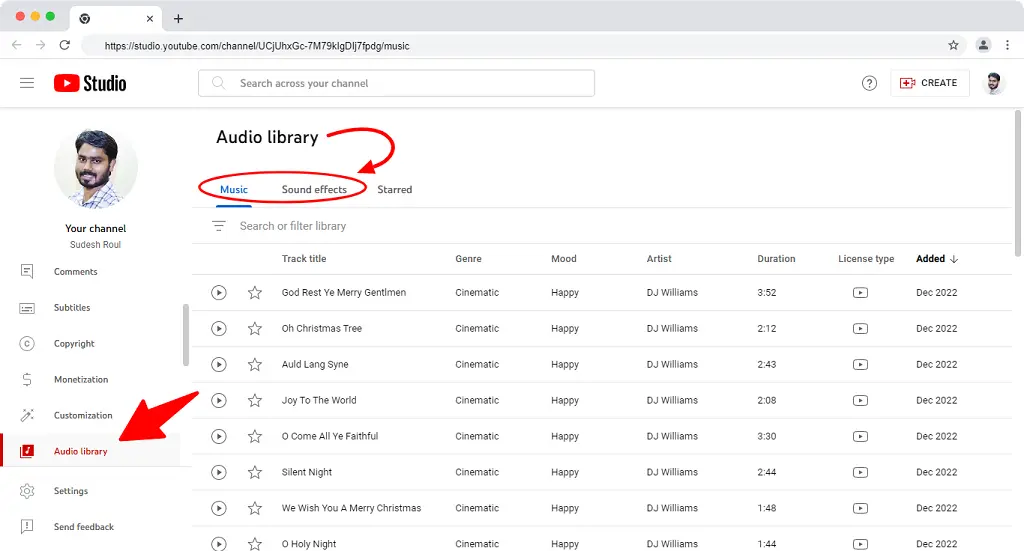
Since the tracks are licensed under Creative Commons, you are not going to have any issues with copyright issues or infringements when using them.
By logging into YouTube Studio, you can access the library. Click ‘Audio Library’ in the left-hand menu. The search can be done by title, artist, keyword, genre, mood, duration, and so on. A new release is added twice a month.
Several tracks are free from copyright because some of them were made by specialist producers in-house, while others were made by external artists. Using their music this way is allowed because the artists are free to use music with attribution.
The good news for YouTubers is that they won’t have to worry about copyright law or licensing while using this safe music for YouTube videos. Unfortunately, there is a limited selection of tracks and you might not be able to find what you are looking for.
Furthermore, you’re likely to use the same tracks as millions of YouTube video creators.
Facebook Sound Collection
Facebook Sound Collection offers royalty-free music and sound effects for creating videos, which you can download. It is then safe to share these videos on Facebook or Instagram without worrying about copyright infringement.
Facebook Sound Collection can only be accessed via a computer where you can preview and download tracks. To create your video and add sounds or tracks, you will need your video creation software. It is not possible to add sounds or music directly to Facebook posts using the Facebook Sound Collection.
Once you have created your video with your video editing software, you can share it on Facebook or Instagram with tracks added from the Facebook Sound Collection.
In your videos, if you use music, sounds, or audio tracks that you don’t own the rights to, you run the risk of your content being taken down for copyright infringement. When you use Facebook Sound Collection, you guarantee that your content has copyright safe music and will not be flagged, blocked, or removed as a result.
Facebook Sound Collection offers high-quality audio tracks that are free. A large library of music and sound effects can be searched, mixed, edited, and downloaded for use in your videos with Facebook Sound Collection.
Difference between Free and Paid Royalty Free Music
Don’t worry if you have trouble understanding some of the phrases used in music licensing, including “royalty-free.” Simply said, royalty-free music is a license that, following a single payment, enables customers to lawfully use the music for the rest of their lives.
You can use music that is not subject to any licensing costs or other legal restrictions in your YouTube videos, Twitch streams, or Instagram posts.
But what is it about royalty-free music that makes it so unique that it may be used in commercial content, social media posts, and streams without facing any repercussions?
Simple: You only need to pay once to use music that is not subject to a license fee! After making a purchase, you are granted lifetime legal access to the song.
You can then use that track in whatever content you produce, including commercials, videos, movies, cartoons, infomercials, school, and work projects, as well as numerous artistic performances.
Whereas in free music, all works not covered by copyright are considered to be free in the public domain and can thus be used without the owner’s consent or payment.
This implies that works in the public domain are open to free duplication, distribution, adaptation, interpretation, and public exhibition as though they belonged to everyone.
In these situations, the aspect of the work that is protected is its recording or interpretation. Music that has no copyright and is virtually open for anybody to use is referred to as “public domain” and it is free for use.
5 Tips to Use Royalty Free Music Safely
✅ Visit a music royalty-free music website library, pick the tune you like best, and get a one-time license to use royalty-free music lawfully. If the composer is given adequate credit in the video, the license may even occasionally be made available for a free license with attribution to you.
✅ One can get royalty-free production music and sound effects to utilize in their videos in YouTube Studio’s Audio Library. The YouTube Audio Library’s music and sound effects are protected by copyright. Consequently, it is safe to use free music on YouTube.
✅ When it comes to commercial uses, royalty-free does not always imply that the song (or image, or video) is available for free. A lot of services make it very obvious that their products cannot be utilized for free for commercial content, such as videos that are being paid for. It is unsafe to use royalty-free music for commercial purposes.
✅ “Royalty-free” denotes that no royalties are due from the person who licenses the song and that you do not own the copyright to the work. The copyright for the music is owned by the composer, who also has the authority to decide whether or not you may use the music.
✅ If the person, people, or organization that owns the rights grants you permission, you may utilize music in videos legally. One must obtain authorization from both the publisher and the record company as they often possess the music rights, from the composer or publisher.
Copyright Free Music vs Royalty Free Music
The terms “Copyright Free” and “Royalty Free” are sometimes used interchangeably. However, because they refer to two different things, the terms do not have the same terminology.
The distinctions between these phrases will never be felt by the typical individual. However, these two ideas can come up for those that use musical or artistic works in their undertakings.
In either case, one should be aware of these distinctions to safeguard themselves against the negative effects of copyright and royalty-free.
Anything that was once copyrighted but no longer carries that label is said to be copyright free. Copyrights do end after a specific period, which varies by nation. The exclusivity period and expiration of that term will both depend on the sort of activity done.
A copyright holder can also work out an arrangement to grant people or organizations some or all of the copyright for their works. These organizations can then make use of those creative works or other products without worrying about consequences.
The situation is different from copyright-free when it comes to royalty-free content or goods. When someone wishes to use a piece of property, the owner grants a license to the licensee.
A transaction with a single payment or additional stipulations might be negotiated between the two parties. After that agreement is reached, the licensee can use that specific property without paying any additional royalties.
They may use certain property for their purposes without being obligated to make any more payments. Non-licensees are not permitted to use the subject property without obtaining their license.
How to Choose Music for Your Video?
Those who create video material are fully aware of the importance of music in capturing viewers’ attention. A distinctive, enjoyable, and pleasant-to-watch feature of your video is the background music that is playing.
Do not disregard the importance of music just because you plan to create a vlog filled with insightful advice or important talks! It is ideal for intros and outros and develops into a key component of your channel.
Those who create video material are fully aware of the importance of music in capturing viewers’ attention. A distinctive, enjoyable, and pleasant-to-watch feature of your video is the background music that is playing.
After you’ve sorted through the feelings and moods, think about the musical styles and instruments that will best forward your mission. Should it be something energetic or low-fi? Consider the tempo of the song as well, as it greatly influences the mood.
Upbeat and brisk music should be your choice if your videos are filled with action and energy and include a lot of things happening. Slow music is appropriate if your material is primarily about comfort and relaxation.
In some cases, if the song fits the storyline and mood of your video, you might have to choose one with a slow start and a rapid finish. The basic goal of background music is to complement, not overpower.
Learn Music Classification to Use the Right Music in Your Video
Which musical style suits you best? Depending on the type of video you’re producing. When selecting background music for videos, there are a few crucial things you should know:
What are Music Genres?
A music genre is a method of classification that divides music into several types. The ability to skillfully blend vocal and instrumental tones systematically is what gives the music its unique style. As a result, there are some formal or stylistic similarities across all artistic creations that fall under the same musical genre.
Literature, television, film, and other genres of artistic expression all use the word “genre” in their works. It examines and highlights the most distinguishing characteristics before combining works that fall into a particular genre.
Crossover genres are equally popular as pure genres. These produce a fresh style that appeals to a wider audience by combining multiple components from various elements.
In popular music, this strategy is frequently employed. However, it’s extremely typical for a musical work to fall under more than one genre at once.
The term “music genre” can be used to describe a piece of music’s compositional period, style, instrumentation, and purpose, as well as its place of geographical origin.
Approximately 1300 different music genres exist today, some of which are challenging to categorize. Music enthusiasts can explore various genres and learn about their differences thanks to a few tools, though. Few examples of music genres:
Cinematic Music
One musical genre comes to mind when words like large, comprehensive, and triumphant come to mind: cinematic music. This is the strongest it can be. Using good cinematic music for wedding videos is a recommendation.
Corporate Music
Corporate Music would want to showcase your most recent offering or inform listeners about a critical topic. In this situation, you require music that will spice up your video just a bit without taking away from its message. While you deliver your message, it should be warm and engaging for the audience.
This is a wonderful application for corporate music because it usually has a warm, inviting vibe without pushing the main attraction off the stage. So, you should use this type of music for advertising videos and films.
Ambient Music
Ambient background music for your video might hit the right note when you need to get a point over to viewers and give them something to listen to without taking over your message. Although ambient music occasionally has a poor rap for being “background music” or “boring,” there is undoubtedly a place and a need for calming tones that don’t draw attention to themselves. Ambient music for cooking videos is the best choice.
The Acoustic Style
These days, acoustic music can be heard in all kinds of videos. Editors like that acoustic is a highly adaptable genre that can be used to create a broad variety of video genres, while viewers generally enjoy the warm tones. Acoustic-style music for vlog videos is a good idea.
Comedy Music
These are the videos that are continually revived by shares and likes on social media and last for years. Every funny video has upbeat background music that makes the viewer smile right away. A combination of ambient and comedy music for travel videos and vlogs is a smart choice.
What are Music Moods?
Although there is a strong correlation between music and mood, how does music affect our mood? There are numerous varieties of moods, and the way that various pieces of music affect our brains might impact how we feel. Music can influence specific moods like happiness or sadness.
Music and mood are closely associated. Your mood can be affected differently by different musical genres. Keep in mind that since everything takes place in your brain, your behavior may also be affected.
Investigating the beneficial connection between your mood and music is straightforward. You can use your favorite music to make your day happier by learning more about the psychology involved.
There is a never-ending collection of different moods. But just some of the main, core moods that most of us experience are:
- Frustrated
- Sad
- Irritated
- Calm
- Happy
- Excited
What are Music Themes?
A theme connects various melodies and serves as the binding agent for a composition. An entire composition may be built around a single theme or a group of motifs in classical music or film scores.
There are many types of themes in music but a few examples are
- Baroque Music theme
- Classical Music theme
- Romantic Era Music theme
What is Instrumental Music?
An instrumental song is one without a singer, and all songs can have sections where the band is playing and the singer is singing softly. But did you know that virtually every song you’ve ever listened to or will listen to has some form of instrumental music?
Yes, instrumental music may be found in practically every type of music, including rock, classical, and hip-hop. As old and extensive as the music itself is its history.
The top 4 categories of instrumental music are:
- Instrumental Rock
- Instrumental Hip Hop
- Instrumental Jazz
- Classical Music
Important FAQs
Is Royalty Free Music Free?
Although royalty-free and copyright-free music may include the word “free” in their names, it isn’t free. However, you avoid the expense of paying royalties and other licensing fees when you license this kind of music.
What is a creative commons license?
A creative commons license is a permit given by the owner of the copyright to anybody in the world to use their work in any way that complies with that license.
In essence, Creative Commons licenses are standard form licensing agreements that may be affixed to work to permit its usage in specific situations without contacting the creator or negotiating terms of use.
Can I use Royalty Free Music on YouTube for Free?
Yes, you can use royalty-free music as long as you initially licensed it, whether you need it for films, commercials for businesses, YouTube videos, etc. It’s a popular misperception that instrumental music is public domain and doesn’t require a license because of this.
Does Royalty Free Music Mean Free for Commercial Use?
Yes, this is the simplest response to this query. You can use royalty-free music as long as you initially licensed it, whether you need it for films, commercials for businesses, YouTube videos, etc.
Can I use Royalty Free Music to Make Money?
Yes, in a nutshell, is the answer to this query. You can use royalty-free music as long as you originally licensed it, whether you need it for films, corporate videos, YouTube videos, or other projects that require music.
